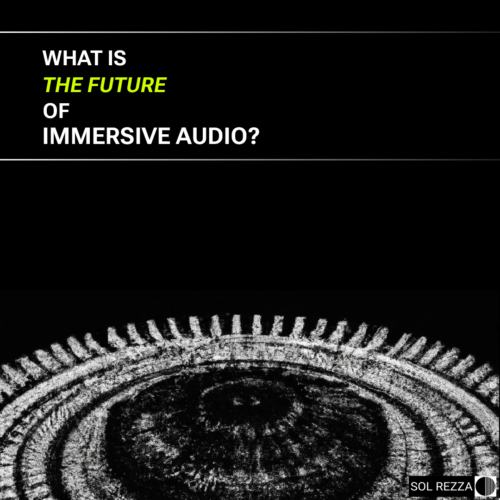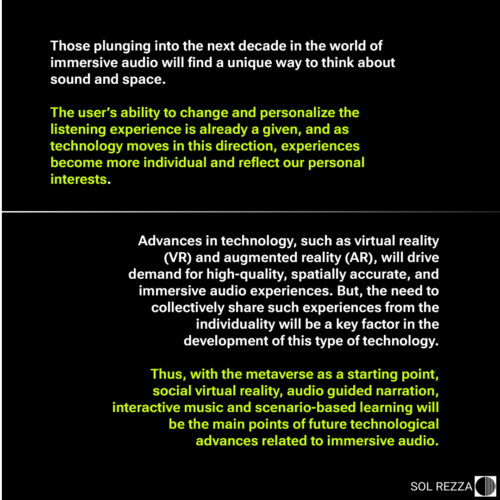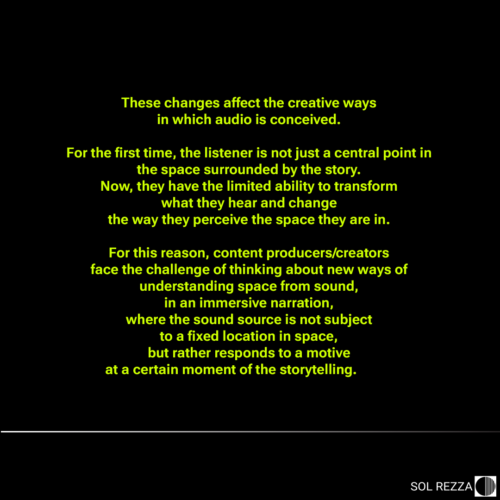Just Around the Corner
In this blog post, we’ll look at the future of immersive audio and the technological innovations that are just around the corner.
Although it may not seem like it, and we think it was a long time ago, from mono to stereo, from stereo to surround, spatial audio has come a long way in a short time.
We are going from being simple listeners to content users. A deep change in our ways of consuming and producing audio.
Now we can offer and experience sonido 3D experiences that adapt to the user’s preferences.

Evolution of Consumption
Those plunging into the next decade in the world of audio will find a unique way to think about sound and space. The user’s ability to change and personalize the listening experience is already a given, and as technology moves in this direction, experiences become more individual and reflect our personal interests.
This opens up a creative range of production possibilities, while limiting the incorporation, by the user, of new unknown experimental experiences that are not part of their immediate environment.
What is not within our reach and what we do not know exists will be almost inaccessible. Algorithms will keep out strange sounds and keep illuminating familiar ones.
However, perhaps it is the technology itself that allows us to cross the established limits, the one that will fail in pursuit of the evolution of consumption, falling into its own trap.
Advances in technology, such as virtual reality (VR) and augmented reality (AR), will drive demand for high-quality, spatially accurate, and immersive audio experiences. But, the need to collectively share such experiences from the individuality will be a key factor in the development of this type of technology.
Thus, with the metaverse as a starting point, social virtual reality, audio guided narration, interactive music and scenario-based learning will be the main points of future technological advances related to immersive audio.
Spatial Possibilities
The radical change that these technologies are producing in the audio industry goes beyond the user being able to change the intensity of what they hear, the equalization or the movement of sound.
These changes affect the creative ways in which audio is conceived. For the first time, the listener is not just a central point in the space surrounded by the story. Now, they have the limited ability to transform what they hear and change the way they perceive the space they are in.
For this reason, content producers/creators face the challenge of thinking about new ways of understanding space from sound, in an immersive narration, where the sound source is not subject to a fixed location in space, but rather responds to a motive (and motif*) at a certain moment of the storytelling.
A better immersive experience will not be provided by “more sophisticated audio engines that can simulate real-world acoustics and create a truly compelling audio environment,” but by our ability to interpret the spatial possibilities of storytelling alongside technological needs and possibilities that the user have.

Accessibility
Like any new technology, the accessibility gap will continue to be part of the market challenges.
Let’s be honest, making technology more accessible and easy to use makes it obsolete for the market. It is enough to look at the fixed telephone hidden in a room of any house. Its sound is alien to us.
It will take several years for viewers to become massive users of high-quality immersive experiences.
Contemporary immersive experiences will largely depend on the producer/creator not sticking to one technology or delivery format, but adapting the experience to different formats, devices, and physical and virtual spaces.
This implies that each experience must consider user attention times for different devices and content formats.
As immersive audio becomes more widespread, users will need to gain new knowledge that allows them to transform the story in more profound ways.
Producers, developers and creatives will have to consider the needs and possibilities of the user at all times during the development of the story.
This will require more complex work teams, with greater technical, creative and planning capacity, which will make it possible to test sound stories before launching them on the market.
While targeted audience analysis will be an absolute necessity, this will not only be necessary for large entertainment companies, but freelance creatives should also take it into account when developing immersive audio work.
All of this will require larger work budgets, development hours, and testing methodologies.

Rethinking context
In conclusion, the future of immersive audio will not only depend on technological development, but the capacity with which we adapt workflows and production to different technologies will have a great impact, keeping in mind the possibilities and needs of the user at all times.
In this context, rethinking approaches to spatiality, acoustics, sound and movement will be an essential starting point for the creation of more complex immersive audio works that adapt to different environments.



